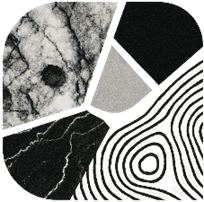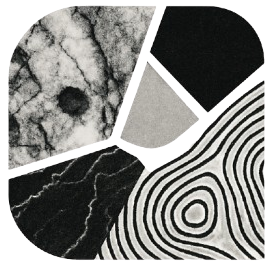Introduction
Estremoz marble is a natural stone from Portugal’s Alentejo region around the towns of Estremoz, Borba and Vila Viçosa. Designers value its clean white and soft pink tones, fine grey veining and ability to elevate luxury interiors. This guide shows you—without jargon—the color varieties, common slab & tile uses (floors, wall cladding, kitchen countertops, bathroom vanity tops, stair treads, skirting/baseboards, window sills, backsplash, thresholds), care basics and the real factors behind pricing. At the end you’ll find a quick buying checklist and a short FAQ.
Estremoz marble is a natural stone from Portugal’s Alentejo region around the towns of Estremoz, Borba and Vila Viçosa. Designers value its clean white and soft pink tones, fine grey veining and ability to elevate luxury interiors. This guide shows you—without jargon—the color varieties, common slab & tile uses (floors, wall cladding, kitchen countertops, bathroom vanity tops, stair treads, skirting/baseboards, window sills, backsplash, thresholds), care basics and the real factors behind pricing. At the end you’ll find a quick buying checklist and a short FAQ.
1. Origin & Key Characteristics
Quarries operating for decades produce blocks ranging from uniform white to delicate pink. The finer the veining and the more consistent the background color, the higher the block grade. The tight crystal structure lets Estremoz take a strong polish yet also look elegant in a honed or lightly textured finish. Blocks are sawn into slabs and then fabricated into tiles, cut‑to‑size panels, stair treads, skirting (baseboards), window sills and custom elements.
Quarries operating for decades produce blocks ranging from uniform white to delicate pink. The finer the veining and the more consistent the background color, the higher the block grade. The tight crystal structure lets Estremoz take a strong polish yet also look elegant in a honed or lightly textured finish. Blocks are sawn into slabs and then fabricated into tiles, cut‑to‑size panels, stair treads, skirting (baseboards), window sills and custom elements.
2. Main Color Varieties
White Estremoz. Bright white to milky background with fine grey or faint rose veins. Ideal for large continuous floor tiles, wall cladding and minimalist kitchen islands.
Pink Estremoz (Rosa / Pink Estremoz). Light blush or peach base with soft grey‑white veining—adds warmth to bathrooms, reception desks and feature walls.
Cream / Beige Tones. Warm neutral background that hides minor wear—practical for high‑traffic hotel lobbies and corridors.
Veined / Dramatic Selection. Some batches show stronger linear or flowing grey/pink bands—great for book‑matched wall panels, fireplace surrounds, statement vanity tops or backsplash accents.
Tip: Uniform light slabs visually expand smaller rooms; bold veining creates a focal feature (e.g. backsplash or feature wall).
White Estremoz. Bright white to milky background with fine grey or faint rose veins. Ideal for large continuous floor tiles, wall cladding and minimalist kitchen islands.
Pink Estremoz (Rosa / Pink Estremoz). Light blush or peach base with soft grey‑white veining—adds warmth to bathrooms, reception desks and feature walls.
Cream / Beige Tones. Warm neutral background that hides minor wear—practical for high‑traffic hotel lobbies and corridors.
Veined / Dramatic Selection. Some batches show stronger linear or flowing grey/pink bands—great for book‑matched wall panels, fireplace surrounds, statement vanity tops or backsplash accents.
Tip: Uniform light slabs visually expand smaller rooms; bold veining creates a focal feature (e.g. backsplash or feature wall).
3. Typical Finishes
For external cladding or exterior stair treads, specify anti‑slip surface (fine honing + brushing or micro‑texture).
- Polished. High gloss, maximizes color depth—popular for wall panels, countertops, fireplace surrounds.
- Honed (matte). Low sheen, diffuses light, hides etching better—common for floor tiles and stair treads.
- Leathered / Lightly Textured. Soft tactile feel, slightly better slip resistance—accent walls, vanity tops.
- Brushed + Honed Combo. Subtle patina for boutique retail or spa floors.
For external cladding or exterior stair treads, specify anti‑slip surface (fine honing + brushing or micro‑texture).

5. Properties & Care
6. Price & Cost Factors (No fake numbers, just real drivers)
7. Quick Comparison: Estremoz vs Rosa Portugal
Rosa Portugal is generally warmer, cloudier and more uniformly pink; white Estremoz offers a cleaner, crisp neutral look for minimalist kitchens or large hotel floor tiles. Many designers mix them: Estremoz for floor and vanity tops, Rosa accents for niche panels or skirting detail.
Rosa Portugal is generally warmer, cloudier and more uniformly pink; white Estremoz offers a cleaner, crisp neutral look for minimalist kitchens or large hotel floor tiles. Many designers mix them: Estremoz for floor and vanity tops, Rosa accents for niche panels or skirting detail.
8. Buying & Logistics Checklist (Step‑by‑Step)
- Request current slab photos (front, back, and close vein detail).
- Confirm slab dimensions & thickness vs your countertop, tile, stair tread and skirting cut‑list.
- Reserve slabs / blocks (quotes usually valid 5–7 days).
- Detail fabrication list: edge profiles (e.g. eased, mitred), backsplash height, vanity sink cutouts, stair nosing, skirting height, window sill drip edges.
- Packaging: Wooden crates for tiles, A‑frames for slabs; label sequence for vein continuity.
- Documents: Commercial invoice, packing list, (if needed) Certificate of Origin & HS code for customs.
- Lead times: Standard slab supply 3–7 working days; complex cut‑to‑size with multiple skirting & stair pieces adds extra time.
- Insurance: Insure long shipments (low cost vs. value).
- Spare material: Order 5–10% extra for on‑site adjustments and future repairs.

9. Pre‑Order Mini Checklist
- Finish choice correct? (Polished / Honed / Leathered)
- Sealing & maintenance plan assigned?
- All cut‑outs (sinks, hob, sockets) marked?
- Skirting / baseboard height unified?
- Stair tread nosing detail confirmed?
- Edge profile for kitchen countertops selected?
- Extra 5–10% material added?
10. Conclusion
Estremoz marble combines timeless white and gentle pink tones with versatile fabrication options—slabs, tiles, cut‑to‑size countertops, vanity tops, stair treads, skirting, backsplash panels and more. Understanding its varieties, finishes, care and cost factors helps you specify the right selection for design and budget. Need current slabs, tile pricing or a 24 h fabrication quote? Send your cut list—we’ll reply with photos and options.
Estremoz marble combines timeless white and gentle pink tones with versatile fabrication options—slabs, tiles, cut‑to‑size countertops, vanity tops, stair treads, skirting, backsplash panels and more. Understanding its varieties, finishes, care and cost factors helps you specify the right selection for design and budget. Need current slabs, tile pricing or a 24 h fabrication quote? Send your cut list—we’ll reply with photos and options.
FAQ
Where does Estremoz marble come from?
From Portugal’s Alentejo region surrounding Estremoz, Borba and Vila Viçosa—an area known for white and pink marble quarries.
What colors does Estremoz marble have?
Primarily bright white, soft pink (Rosa / Pink Estremoz) and warm cream‑beige tones, sometimes with fine grey or rose veining.
Is Estremoz marble good for kitchen countertops and islands?
Yes, with normal marble care: seal it, wipe acidic spills quickly and use boards for cutting to reduce etching.
Does Estremoz marble stain easily?
Moderate porosity. Sealed surfaces resist most stains; unsealed stone can absorb oil or wine if left standing.
How often should Estremoz marble be sealed?
Typically every 12 months for residential countertops and floor tiles; inspect high‑traffic commercial areas more frequently.
What edges / fabricated pieces can I order?
Common: eased edge, mitred apron for thick‑look countertops, stair treads with bullnose or chamfer, skirting/baseboards, vanity tops with backsplash, window sills, thresholds.
Where does Estremoz marble come from?
From Portugal’s Alentejo region surrounding Estremoz, Borba and Vila Viçosa—an area known for white and pink marble quarries.
What colors does Estremoz marble have?
Primarily bright white, soft pink (Rosa / Pink Estremoz) and warm cream‑beige tones, sometimes with fine grey or rose veining.
Is Estremoz marble good for kitchen countertops and islands?
Yes, with normal marble care: seal it, wipe acidic spills quickly and use boards for cutting to reduce etching.
Does Estremoz marble stain easily?
Moderate porosity. Sealed surfaces resist most stains; unsealed stone can absorb oil or wine if left standing.
How often should Estremoz marble be sealed?
Typically every 12 months for residential countertops and floor tiles; inspect high‑traffic commercial areas more frequently.
What edges / fabricated pieces can I order?
Common: eased edge, mitred apron for thick‑look countertops, stair treads with bullnose or chamfer, skirting/baseboards, vanity tops with backsplash, window sills, thresholds.

